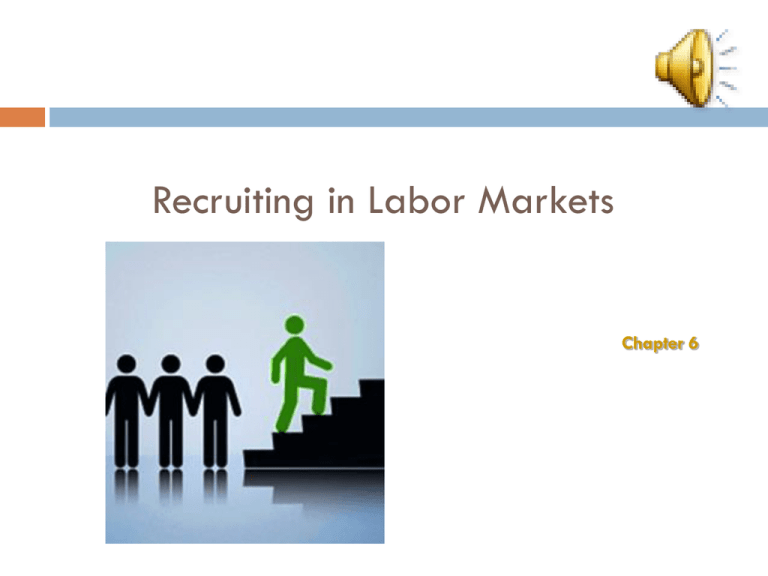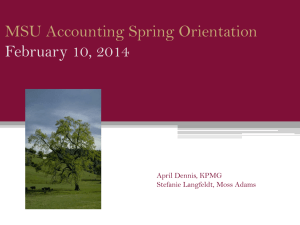6 - leadmore.org
advertisement

Recruiting in Labor Markets Chapter 6 Strategic Recruiting Decisions Organization-Based vs. Sample Outsourced Recruiting Recruiting Source Choices: Internal vs. External Recruiting Nontraditional Sample Workers Recruiting Presence Sample and Image Strategic Sample Recruiting Decisions Training of Sample Recruiters Recruiting and EEO: Diversity Sample Considerations Regular vs. Sample Flexible Staffing Realistic Job Sample Previews 6–2 Strategic Approach to Recruiting Benefits of a Strategic Approach Matches recruiting activity with organizational and human resource plans. Acquiring the Right Human Capital Entails: Knowing the business and industry to successfully recruit qualified employees Identifying keys to success in the labor market, including ways to deal with competitors’ recruiting efforts (cherry picking!) Cultivating networks and relationships with sources of prospective employees Promoting the company brand so that the organization becomes known as a good place to work Creating recruiting metrics in order to measure the effectiveness of recruiting efforts (offer:acceptance ratio) Recruiting and Labor Markets Definitions Recruiting Labor Markets The process of generating a pool of qualified applicants for organizational jobs The external supply pool from which organizations attract their employees Tight versus Loose Labor Markets Low unemployment creates competition for employees, raising labor costs. High unemployment results the availability of more applicants and more qualified applicants. Labor Market Components Definitions Labor Force Population All individuals who are available for selection if all possible recruitment strategies are used. Applicant Population A subset of the labor force that is available for selection using a particular recruiting approach. Applicant Pool All persons who are actually evaluated for selection Strategic Recruiting Decisions Organization-Based vs. Outsourced Recruiting HR knows organization best Outsourcing frees up time, cost savings, often better access to markets, understands the industry better and decreases HR Staff Professional Employer Organizations (PEOs) and Employee Leasing Saves HR costs but increases total payroll costs Increases compliance with government regulations and requirements. Benefits may be more available Regular vs. Flexible Staffing Flexible Staffing The use of workers who are not traditional employees. Temporary workers Hiring temporary staff members or contracting with agencies supplying temporary workers on a rate-per-day or rateper-week basis. Independent Workers contractors who perform specific services on a contract basis. Cost/Benefit of Flexible Staffing Internal Recruiting Organizational Databases Profiles containing background and KSA information on current employees that allow for key word searches to locate suitable candidates for open positions and career development. Skills Management System(s) Job Posting A system in which the employer provides notices of job openings and employees respond by applying. Promotions and Transfers Upward and lateral movements of employees Employee-Focused Recruiting Current-Employee Referrals A reliable source composed of acquaintances, friends, and family members of employees that are recommended by current employees. Can violate EEO regulations if it is the sole source of applicants. Re-recruiting of Former Employees and Applicants Individuals to return. who have left for other jobs might be willing External Recruiting College and University Recruiting Media Sources and Job Fairs Competitive Sources High Schools and Technical Schools External Recruiting Sources Labor Unions Employment Agencies and Headhunters Internet Recruiting (cont’d) Advantages Disadvantages Recruiting cost savings More unqualified applicants Recruiting time savings Expanded pool of applicants Additional work for HR staff members Many applicants are not seriously seeking employment Access limited or unavailable to some applicants Morale building for current employees Use technology to counter this such as key word search. E.g., screening software Legal Issues in Internet Recruiting The use (or misuse) of screening software Collection of federally required applicant information Exclusion of protected classes from the process Legal Issues in Internet Recruiting Proper identification of “real” applicants Maintaining confidentiality and privacy 6–12 © 2011 Cengage L General Recruiting Process Metrics Offer:Acceptance Ratio Yield ratios The percentage hired from a given group of candidates. Acceptance Rate A comparison of the number of applicants at one stage of the recruiting process to the number at the next stage. Selection rate arguably the most important yield ratio The percent of applicants who accepted a job offers divided by total number of applicants who received job offers. Success Base Rate Comparing the percentage rate of past applicants who were good employees to that of current employees. Sample Recruiting Evaluation Pyramid







